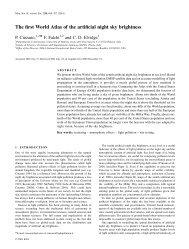slides
slides
slides
You also want an ePaper? Increase the reach of your titles
YUMPU automatically turns print PDFs into web optimized ePapers that Google loves.
Approach<br />
atmosphere divided in 3D grid<br />
surface in a corresponding 2D grid<br />
atmospheric situation and scattering functions of each volume from<br />
up-to-date models of atmospheric physics<br />
the source has a given upward intensity function<br />
Garstang-like ray-tracing approach<br />
irradiance from the source on each atmospheric volume is<br />
calculated (accounting for extinction, absorption, etc.)<br />
intensity of the light scattered in each direction by each volume<br />
(numerical approximation) based on detailed scattering properties<br />
irradiance on each surface area from each atmospheric volume<br />
and intensity of the light scattered in each direction<br />
start iterations: irradiance on each atmospheric volume and on<br />
each surface area is calculated, due to light coming from other<br />
volumes, other surface areas and the source. The intensity of the<br />
light scattered in each direction is added. Then another iteration.<br />
at the end, the intensity of light scattered by each volume in each<br />
direction is known, and also the radiation density, etc.<br />
brightness obtained from simple integration along the line-of-sight



